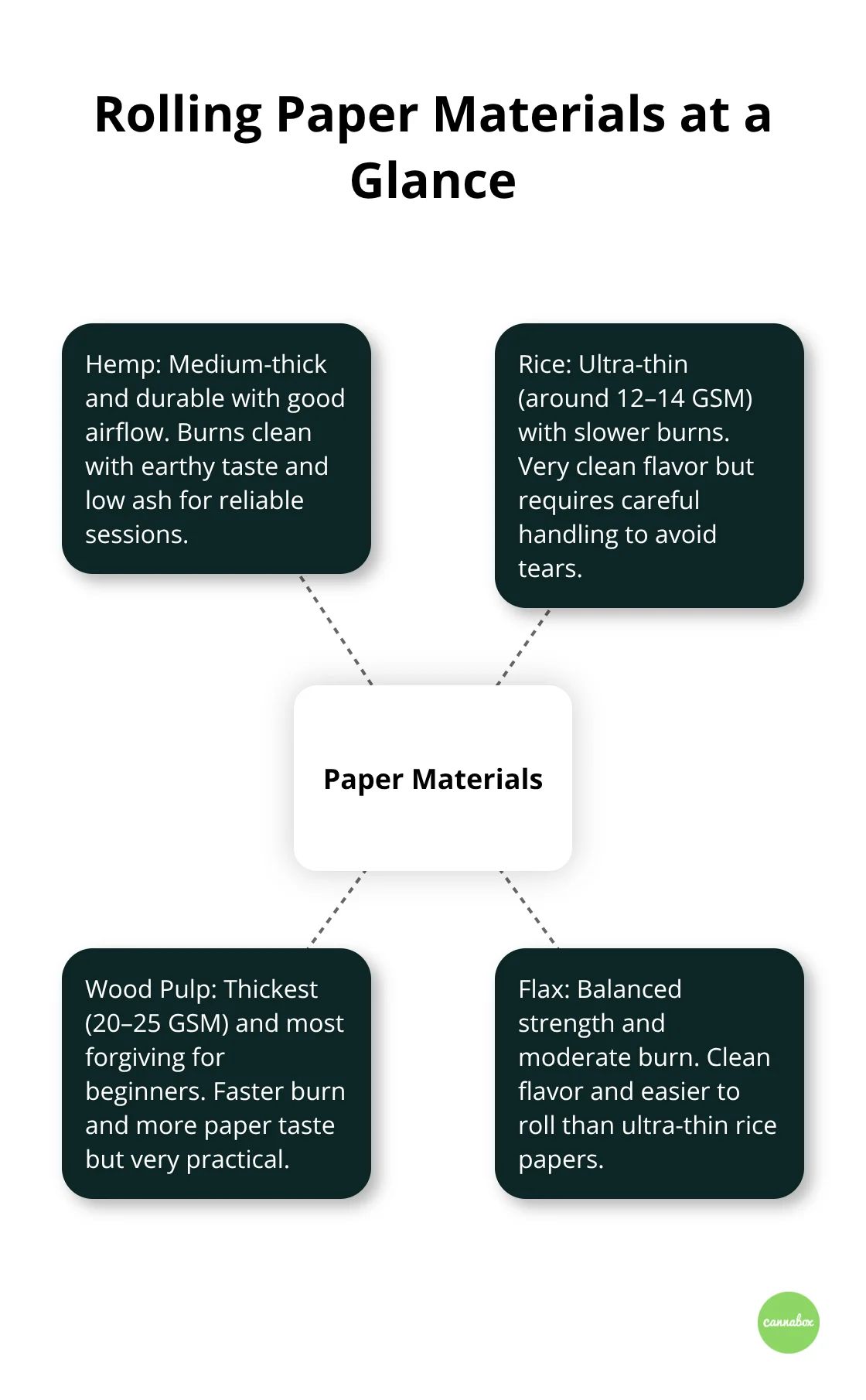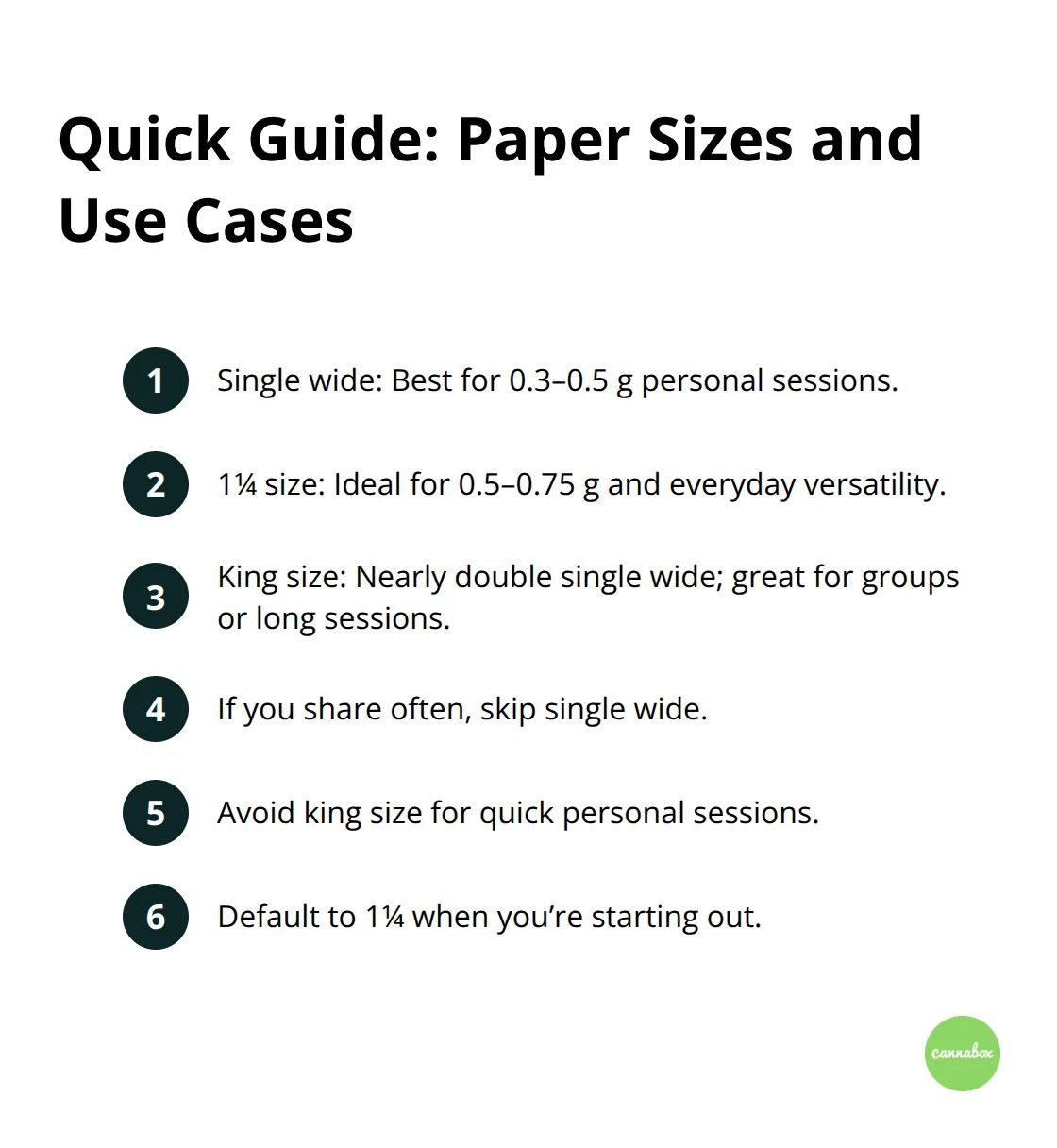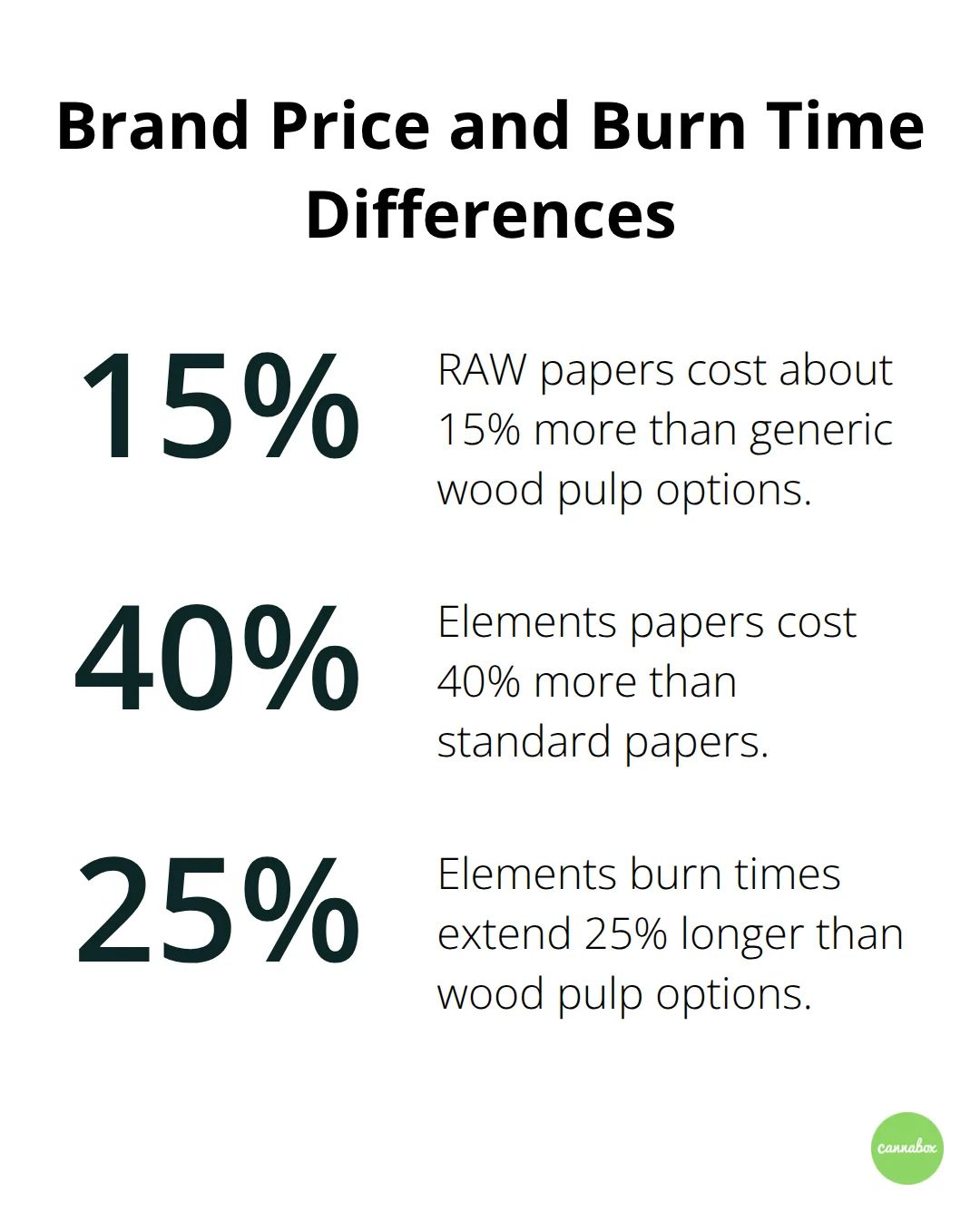Choosing the right rolling papers can make or break your smoking session. The wrong paper burns too fast, tastes harsh, or falls apart mid-smoke.
We at Cannabox know that with dozens of brands and materials available, finding your perfect match feels overwhelming. This guide breaks down everything you need to know about selecting rolling papers that match your preferences and smoking style.
Which Rolling Paper Material Works Best?
Hemp Papers Deliver Natural Strength
Hemp rolling papers stand out as the most durable option for serious smokers. These papers offer more airflow and bigger draws due to their porous nature, which gives you more time to enjoy your session without constant relights. The natural fibers create a medium-thick paper that handles moisture better than alternatives, and this makes the process easier for beginners who struggle with ultra-thin options. Hemp papers also produce less ash compared to wood pulp, which keeps your area cleaner. The earthy taste complements cannabis flavors without overpowering them, and the unbleached brown color indicates that no harsh chemicals were used in the process.
Rice Papers Offer Ultra-Thin Performance
Rice papers represent the premium choice for experienced rollers who prioritize flavor purity. These papers measure just 12-14 GSM thickness compared to 18-20 GSM for hemp papers, and this creates an almost transparent appearance. Rice papers provide a slower burn rate due to their less-porous construction, which means you get maximum value from your material while the minimal paper taste lets natural terpenes shine through. Rice papers require more skill to roll due to their delicate nature, but the clean smoke and reduced ash make the extra effort worthwhile for flavor enthusiasts.
Wood Pulp Papers Balance Cost and Convenience
Wood pulp papers remain the most affordable and accessible option (typically 30-50% less than hemp or rice alternatives). These traditional papers offer the thickest construction at 20-25 GSM, which makes them forgiving for new rollers who need extra durability during the process. The faster burn rate works well for quick sessions, though you’ll taste more paper flavor compared to natural alternatives. Wood pulp papers stick reliably and handle different humidity conditions without becoming too brittle or sticky, which makes them practical for everyday use when budget matters more than premium experience.

Flax Papers Provide Middle Ground Performance
Flax-based papers offer a balanced option between thin and thick varieties while maintaining a clean flavor profile. These papers burn at a moderate rate (approximately 3 minutes and 30 seconds) and provide enough strength for confident rolling without the delicate handling that rice papers require. Flax papers cost slightly more than wood pulp but less than premium rice options, making them an attractive choice for regular smokers who want quality without the highest price point.
Now that you understand the material differences, the next step involves choosing the right thickness and size for your specific needs.
What Paper Features Actually Matter for Your Sessions?
Thickness Controls Your Roll Success and Burn Speed
Paper thickness directly impacts both your roll experience and smoke quality, with measurements that range from ultra-thin 12 GSM rice papers to sturdy 25 GSM wood pulp options. Thicker papers above 20 GSM burn faster but handle moisture and beginner mistakes better, while papers under 15 GSM provide slower burns that stretch your material further but tear easily during rolls. Tests by manufacturers show that rice papers burn slower than wood pulp due to denser fiber construction, with king-size rice papers burning for 12-14 minutes compared to shorter times for standard wood pulp papers. Choose thicker papers if you roll in humid conditions or struggle with delicate materials, but switch to ultra-thin options when you want maximum flavor and longer sessions.
Size Selection Changes Everything About Your Experience
Single wide papers work best for personal sessions with 0.3 to 0.5 grams of material, while 1¼ size accommodates 0.5 to 0.75 grams and remains the most popular choice across North America. King size papers hold nearly double the material of single wide options, which makes them perfect for group sessions or extended solo smoke, though they require more advanced skills to avoid loose construction. Regional preferences show clear patterns (European smokers favor king size slim papers for their length-to-width ratio, while American users stick with 1¼ for versatility). Skip single wide if you share frequently, avoid king size for quick personal sessions, and choose 1¼ as your default size when you start out.

Natural Papers Preserve Flavor While Synthetic Options Mask Quality
Unbleached papers preserve the natural terpene profile of your material without chemical tastes, while bleached white papers can contain calcium carbonate and other additives that create harsh aftertastes. Natural gum Arabic adhesives provide tasteless seals compared to synthetic glues that leave metallic or sweet flavors, and hemp or rice papers allow terpenes to express fully without interference. Choose unbleached brown papers for premium flower, avoid flavored papers that mask quality, and test different adhesive types to find options that don’t affect your smoke’s natural character.
These technical specifications matter, but brand reputation and consistent quality often determine which papers deliver the best results session after session.
Which Brands Actually Deliver Premium Quality?
RAW Papers Set the Standard for Natural Performance
RAW rolling papers dominate the natural market with their unrefined approach that preserves plant fiber integrity without chemical processing. These papers burn at exactly the same rate as your material, which eliminates the harsh aftertaste that bleached alternatives create. RAW uses a criss-cross watermark pattern that controls airflow and prevents runs, while their natural brown color indicates zero chlorine or calcium carbonate additives. The brand offers consistent thickness across all sizes, with their classic 1¼ papers at 14 GSM for reliable rolls without tears. RAW papers cost approximately 15% more than generic wood pulp options but deliver significantly longer burn times that stretch your material further.
Zig-Zag Provides Reliable Performance Across All Skill Levels
Zig-Zag papers have maintained consistent quality since 1879, which makes them the most trusted choice for smokers who need dependable results every time. Their orange package papers use French wood pulp that balances thickness and burn speed perfectly for beginners, while the ultra-thin blue package offers rice paper performance at lower costs. Zig-Zag papers stick reliably in all humidity conditions due to their Arabic gum strip that activates easily without excess moisture, and their corner-cut design prevents adhesive overlap that creates uneven burns. These papers cost 20-30% less than premium rice alternatives while they maintain burn consistency that matches more expensive brands.
Elements Rice Papers Excel for Flavor-First Sessions
Elements rice papers provide ultra-thin construction that creates almost transparent sheets that burn slower than any wood pulp alternative. These papers produce minimal ash and zero paper taste, which allows terpene profiles to express fully without interference from chemicals. Elements uses pure rice and sugar cane fibers with natural acacia gum adhesive that seals perfectly without metallic aftertastes. The brand costs 40% more than standard papers but delivers burn times that extend 25% longer than wood pulp options (which makes them cost-effective for premium material where flavor matters most).

OCB Papers Combine French Heritage with Modern Innovation
OCB papers originated in France in 1918 and continue to offer diverse material options that include organic hemp and unbleached varieties for environmentally-conscious users. Their premium line features ultra-thin construction that rivals Elements while their standard papers provide reliable performance at competitive prices. OCB papers use natural gum adhesive that activates smoothly and their consistent manufacturing process reduces defects that cause uneven burns or tears during rolls.
Final Thoughts
Your rolling paper choice should match your habits and skill level. New rollers benefit from thicker hemp or wood pulp papers that forgive mistakes, while experienced users can handle delicate rice papers that preserve flavor. Quick sessions work best with faster wood pulp, but extended sessions require slow rice or hemp options.
Quality rolling papers enhance every aspect of your experience. Premium brands like RAW, Elements, and Zig-Zag deliver consistent performance that cheap alternatives cannot match. The extra cost pays off through better flavor, longer burn times, and fewer failed rolls that waste your material (especially with premium flower).
Smart investment means you buy papers that fit your actual needs rather than chase the most expensive options. Regular smokers should stock multiple types for different situations, while occasional users can stick with versatile 1¼ hemp papers that handle most scenarios well. We at Cannabox include premium rolling papers alongside other curated accessories in our monthly subscription boxes, which helps you test new brands and products that elevate your sessions.



